Japan In Late Fall
December 14th, 2013Last spring we made our first visit to Japan, arriving in Fukuoka at the height of cherry blossom season. It was a terrific trip, and my husband and daughter were soon plotting a return that would let us view the fall foliage. We’ve just returned from that adventure, and it too was a success.
The Internet decreed that early December would be the peak of the fall foliage season in southern Japan, so we set our trip for that time — though December seemed very late in the year to me. As it turned out, we were probably two weeks past the peak of the maple foliage season. Nevertheless, there was still a lot of color and many spectacular sights. The advantage of our late arrival? Far smaller crowds than we would have faced only a week or two earlier.
We did most of our in-country traveling on the Shinkansen, taking the train from Fukuoka to Kyoto, and then Kyoto to Kumamoto via Himeji. The Shinkansen is awesome, and a joy to ride, although views are limited because much of the track in southern Japan passes through tunnels, or between walls that I presume are noise buffers.
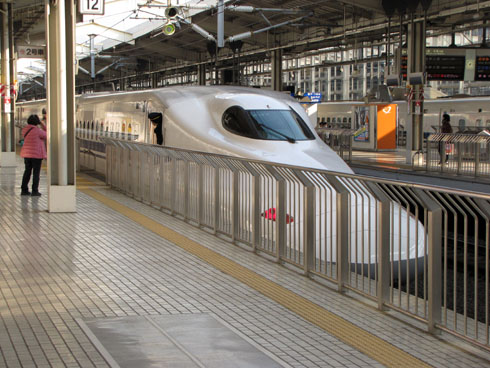
Kyoto has a historic district with traditional streets and buildings, that house many small shops and restaurants. Shrines and gardens are everywhere. This is one of the brightest Japanese maples we saw, thriving in a Kyoto park:

The sightseeing highlight of the trip for me was our visit to the Fushimi Inari Shrine on the outskirts of Kyoto. We took a train, arriving at a station right across the narrow street from the shrine. The unique feature of Fushimi Inari is a path that wends in a loop trail up to the top of a forested hill behind the main temple buildings. The path passes beneath literally hundreds of torii gates, most painted bright orange, with a few constructed of bare, gray stone. Smaller shrines are found along the way. The path was very crowded at the bottom, but the higher we climbed, the fewer people we saw. There were only a handful of people around when we reached the top. The walk was utterly gorgeous, and I highly recommend it.
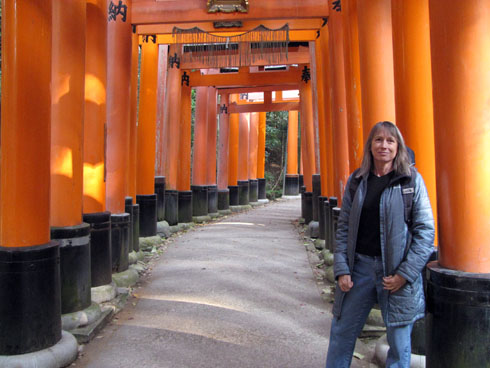
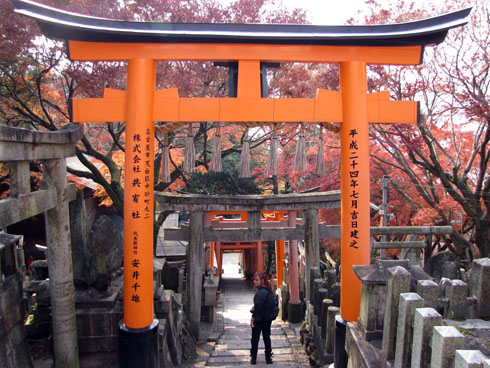
Some of the best fall colors we saw were along the Fushimi Inari Shrine torii path:
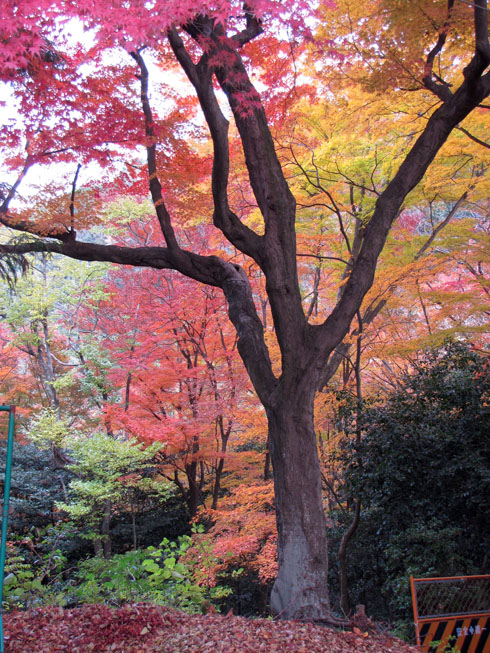
After Fushimi Inari, we took the train back to Kyoto and visited another well-known site: the Kiyomizu Shrine. Here, the main buildings were undergoing renovations, great crowds of tourists were mobbing the paths and the lookouts, and the maple leaves were quite past their prime, but despite all this the grounds were beautiful, and the visit definitely worthwhile.
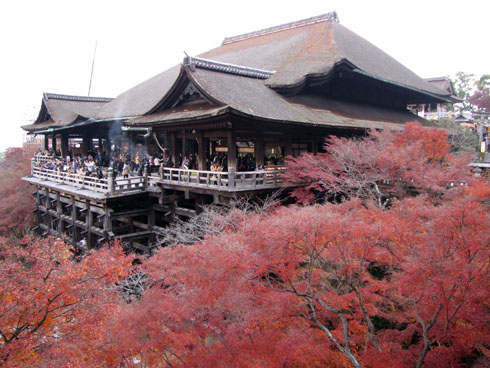
After three nights in Kyoto we headed south again, stopping overnight in the small city of Himeji. Our goal was to see Himeji Castle, which is considered to be the best example of an original (not rebuilt) castle in Japan. Unfortunately, (and unknown to us before we arrived!) the castle is currently undergoing extensive renovation, with the main tower fully enclosed within scaffolding and protective coverings. We toured the castle grounds anyway, and while there we met an American expatriate who has lived in Himeji for many years. He’s retired now, and enjoys meeting foreigners who come to see the castle. He provided us with a guided tour around the grounds, sharing with us far more history of the castle and the land around than we ever would have gleaned on our own — and now we are all facebook friends.
This is a photo of Japanese maples in a garden on the castle grounds:
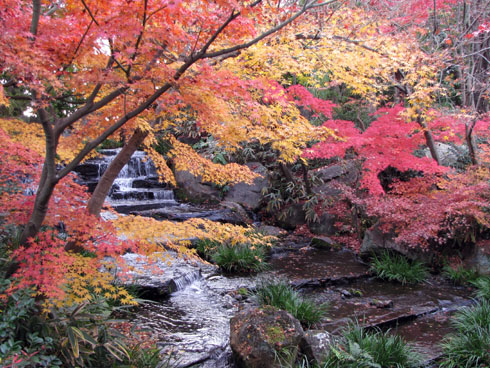
The last three nights of our trip were spent in Kumamoto, where we had visited last spring. For me, one of the wonderful things about Japan is the way that small, beautiful shrines appear in unexpected places within the cities. This photo was taken in a tiny shrine very close to our hotel with a massive Ginkgo tree, blazing with bright yellow foliage:

Last spring we visited Kumamoto Castle at the height of cherry blossom season. The grounds looked very different this time, but it was still quite beautiful. Kumamoto Castle is rebuilt with modern architectural techniques. The interior of the main tower is a museum — but don’t let this discourage you. It’s spectacular to see and contains many fascinating exhibits.

Viewing the fall foliage was only one purpose of our trip. The other purpose, the one closest to my husband’s heart, was to find his Japanese family. Ron’s grandparents emigrated to Hawaii in the early part of the 20th century. Both his grandparents and his mother kept in contact with the relatives back in Japan. But a few years ago, when his mother passed away, contact with the family was lost. I’m happy to report that, with the help of an interpreter and an incredible stroke of luck, we were able to meet the Nagata family of Kumamoto Prefecture, who turned out to be wonderful, friendly people who were as eager to renew a relationship with their American relatives as we were to find them. So we are calling this visit to Japan a glorious success!
Posted on: Saturday, December 14th, 2013 at 10:43 am
Categories: Travel.
Tags: Fukuoka, Himeji, Japan, Japanese maples, Kumamoto, Kumamoto Castle, Kyoto








December 14th, 2013 at 10:57 am
Beautiful colors. My hope is to go one day.
FOOD: been to Ivan Ramen yet?
Would like to hear more about noodle shops you’ve been to.
December 14th, 2013 at 11:08 am
Our usual method is to wander about, looking at restaurant signs and prices, and randomly pick a place. We always ask for an English menu, but don’t always get one. Fortunately, my daughter can read just enough kanji that we can get by. Noodle shops tend to be very specific: either udon, somen, or ramen. I’m not a huge fan of udon in Hawaii. Here, the noodles are really fat and starchy. The udon I had in Japan had thinner noodles and for me was much tastier. I’m told the ramen in Kumamoto is quite distinct. It has a rich pork broth, which is delicious. One of the best meals we had was lunch at a little restaurant in a country town. Several different dishes, all excellent and only around 650 yen. Prices in the cities are higher, but still much less than we pay in Hawaii.
December 16th, 2013 at 10:01 am
My mom’s family is from Kumamoto. Enjoyed the pictures and commentary, Linda! Maybe one day I’ll get to do this…
December 16th, 2013 at 10:13 am
I hope you do, Kenn! Both visits were so fun, and finding the family was a great experience.
December 17th, 2013 at 1:26 pm
Wow! I just love all the vibrant colors – it illuminates freshness!!! Mahalo for sharing and I’m so grateful that the main reason was accomplished, to reconnect with ‘ohana. How exciting that must be. My mother-in-law is pure Japanese and has done extensive research on her family. I should learn more and create a reason to go too. For her 80th Birthday we all chipped in money to send her but at the time, no one wanted to accompany her. She’s now 87, we need to go 🙂 Hopefully sooner than later. Mahalo for sharing !
December 17th, 2013 at 5:53 pm
Thanks, Moani! And yes, you do need to go. It really helps to have someone along who speaks and reads a little Japanese.